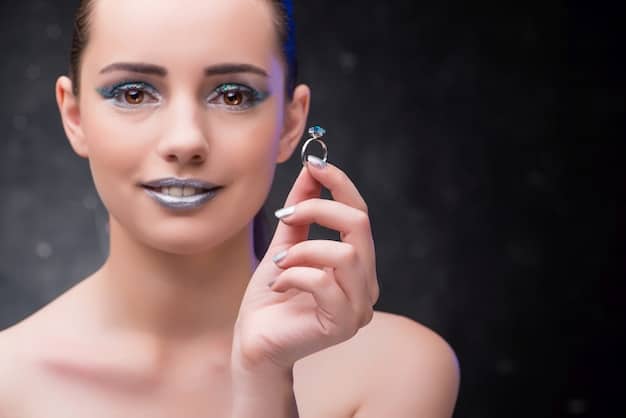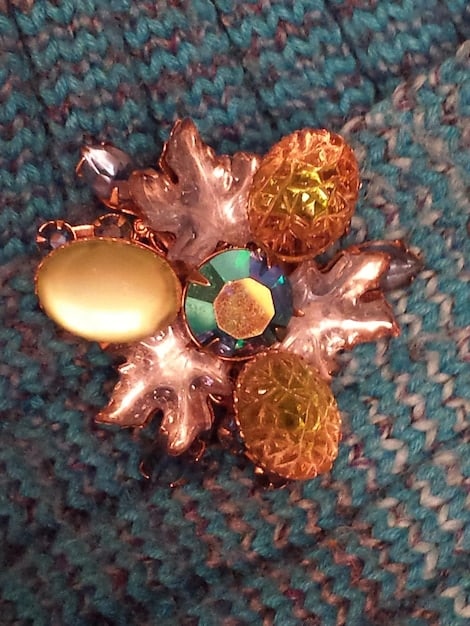The Ultimate Guide to Choosing the Right Jewelry for Your Skin Tone

Anúncios
Selecting the right jewelry is an art, and understanding how different metals and gemstones complement your unique skin tone is essential for enhancing your natural beauty and achieving a harmonious look.
Unlocking your personal style often involves intricate details, and few elements are as transformative as jewelry. This guide, The Ultimate Guide to Choosing the Right Jewelry for Your Skin Tone, delves into the nuances of selecting pieces that truly enhance your natural radiance. Discover how understanding your skin’s undertones can revolutionize your accessory choices.
Anúncios
Understanding Your Skin’s Undertone
To truly master the art of selecting jewelry that harmonizes with your appearance, it is crucial to first identify your skin’s undertone. This often-overlooked aspect plays a pivotal role in determining whether certain metals and gemstones will enhance or detract from your natural glow. Your skin’s undertone is the subtle hue beneath the surface, distinct from your overt skin color, which can change with sun exposure.
There are generally three primary undertones: warm, cool, and neutral. Identifying yours is the foundational step in building a jewelry collection that consistently flatters your complexion. This understanding transcends fleeting trends, providing a timeless framework for your accessory choices.
Anúncios
The Vein Test: A Simple Starting Point
One of the easiest and most common methods to determine your undertone involves examining the veins on your wrist. This simple visual cue provides a quick and reliable indicator of your underlying skin hue.
- Blue or Purple Veins: If your veins appear predominantly blue or purple, you likely have a cool undertone.
- Green Veins: Veins that look green suggest a warm undertone.
- Mixed (Blue and Green) Veins: If you struggle to categorize your veins as distinctly blue/purple or green, or if they seem to be a mix, you probably have a neutral undertone.
This test works best in natural daylight, as artificial lighting can distort colors and lead to an inaccurate assessment. Hold your wrist up to natural light and observe the color of your veins closely to get the most accurate result.
The Paper Test: Another Illuminating Method
Beyond the vein test, the paper test offers another effective way to identify your undertone. This method involves comparing your skin to a crisp, white surface, allowing your undertones to become more apparent against the stark contrast.
- Draping Technique: Hold a piece of pure white paper or fabric next to your bare face or neck. Avoid using colored clothing or makeup, as these can influence your perception of your skin’s color.
- Observation in Natural Light: Stand in natural lighting, ideally near a window, and observe how your skin appears against the white background.
- Identifying the Cast: If your skin appears yellowish, peachy, or golden, you have a warm undertone. If it looks pink, rosy, or blue-ish, your undertone is cool. If you see a balance, or it’s hard to tell, you’re likely neutral.
This test helps to isolate the subtle undertones that might otherwise blend into your overall skin color. It’s an excellent complementary test to the vein assessment, providing a clearer picture of your skin’s natural hue.
The Sun Test: Observing Your Skin’s Reaction to the Sun
How your skin reacts to sun exposure can also offer valuable clues about your undertone. This method, while less immediate, provides insight into your skin’s natural pigmentation and how it interacts with light.
- Cool Undertones: Individuals with cool undertones tend to burn easily and rarely tan. Their skin might turn red or pink after sun exposure.
- Warm Undertones: Those with warm undertones often tan easily and rarely burn. Their skin typically takes on a golden or bronzed hue from the sun.
- Neutral Undertones: People with neutral undertones might tan gradually and may or may not burn, exhibiting a balanced reaction to sun exposure.
This test provides a cumulative understanding of your skin’s inherent characteristics, reinforcing the findings from the vein and paper tests. By combining these methods, you can confidently determine your unique undertone, paving the way for informed jewelry choices.
Jewelry for Warm Undertones
Once you’ve identified your undertone as warm, a world of beautiful jewelry options opens up, specifically those that highlight your skin’s natural golden and peachy hues. Warm undertones are typically characterized by skin that has a yellowish, golden, or olive cast, and veins that appear green. The goal is to choose metals and gemstones that complement these inherent colors, creating a cohesive and radiant look.
The right jewelry can make your skin look more vibrant and your features more defined, while the wrong choices can make you appear washed out or dull. For warm undertones, the key is to lean into rich, earthy tones and metals that resonate with warmth.
Best Metals for Warm Undertones
For individuals with warm undertones, the metals that truly shine are those with golden or copper hues. These metals naturally complement the warm glow of your skin, enhancing its radiance rather than clashing with it.
- Gold: Yellow gold is the quintessential metal for warm undertones. Its rich, golden hue perfectly complements the warm glow of your skin, making it appear more vibrant. Whether it’s a statement necklace, delicate earrings, or a classic bracelet, yellow gold pieces will always look stunning on you.
- Rose Gold: While often considered versatile, rose gold, with its subtle pinkish-reddish tint, also works wonderfully for warm undertones. It offers a softer warmth than yellow gold and can add a romantic touch to your look.
- Copper and Brass: For a more rustic or bohemian aesthetic, copper and brass jewelry are excellent choices. Their earthy, reddish-brown tones resonate beautifully with warm skin undertones, offering a unique and distinctive style.
These metals will make your skin look healthier and more luminous, bringing out its natural warmth. It’s about creating a harmonious palette where your skin and jewelry enhance each other.
Ideal Gemstones for Warm Undertones
When it comes to gemstones, those with warm undertones should gravitate towards colors that echo the warm spectrum. Think of the colors of a sunset or a lush forest – these hues will beautifully accent your skin.
- Earthy Tones: Gemstones in shades of brown, amber, orange, and deep red are incredibly flattering. Examples include amber, garnet, citrine, and carnelian. These colors draw out the golden and peachy tones in your skin.
- Greens and Blues with Yellow Casts: While green and blue can sometimes be cool, certain variations work well for warm undertones. Look for greens with a yellowish cast, like emerald or peridot, or blues that lean towards teal or turquoise.
- Neutral and Creamy Hues: Pearls with a cream or yellowish overtone, as well as diamonds, can also be worn, as they are versatile and tend to reflect the colors around them.
Choosing gemstones that align with your undertone ensures that your jewelry doesn’t just sit on your skin, but rather becomes an extension of your natural beauty, enhancing your overall appearance. Experiment with different shades to discover what truly makes you glow.
Jewelry for Cool Undertones
For those with cool undertones, the selection of jewelry shifts towards metals and gemstones that highlight blue, pink, or rosy casts in the skin. Cool undertones are characterized by skin that may appear to have a pinkish or bluish hue, and veins that look blue or purple. The aim here is to choose pieces that counteract any potential redness and brighten your complexion, creating a crisp and elegant contrast.
The right choices will make your skin look fresh and radiant, while the wrong ones could make you appear sallow or dull. For cool undertones, the emphasis is on crisp, cool-toned metals and vibrant, clear gemstones that reflect light beautifully.
Best Metals for Cool Undertones
Individuals with cool undertones will find that silvery and white metals are their most flattering options. These metals complement the cool hues in their skin, providing a bright and sophisticated touch.
- Silver: Sterling silver is a superb choice for cool undertones. Its bright, cool sheen beautifully complements the pinks and blues in your skin, making it look crisp and vibrant. Silver jewelry has a timeless elegance that enhances almost any outfit.
- White Gold: Similar to silver but with a richer luster, white gold is another excellent option. It offers the luxurious feel of gold while maintaining a cool, sophisticated tone that harmonizes with your skin.
- Platinum: As a premium white metal, platinum is highly durable and naturally hypoallergenic, making it an ideal choice for cool undertones. Its bright, silvery-white appearance enhances the luminosity of cool-toned skin.
These metals create a beautiful contrast with your skin, making it appear more radiant and enhancing your natural beauty. They provide a clean, modern look that perfectly complements cool undertones.
Ideal Gemstones for Cool Undertones
When selecting gemstones, those with cool undertones should focus on colors that have blue, purple, or green casts. These colors will highlight the natural coolness of your skin, bringing out its luminosity.
- Blues and Purples: Gemstones in varying shades of blue, such as sapphire, aquamarine, and topaz, are incredibly flattering. Also, purples like amethyst and tanzanite will bring out the cool hues in your skin.
- Greens with Blue Casts: Look for greens that lean towards blue, like emeralds or jades. These shades will complement your skin without clashing.
- Pinks and Reds with Blue Undertones: Certain shades of pink and red, particularly those with cooler undertones like ruby or rose quartz with cooler, purplish-pink casts, can also be stunning.
Choosing gemstones that resonate with your cool undertone will ensure that your jewelry pieces do not just accessorize your outfit but also enhance your natural complexion, making you look more vibrant and put-together.

Jewelry for Neutral Undertones
If you have neutral undertones, consider yourself fortunate, as you have the most versatility when it comes to choosing jewelry. Neutral undertones exhibit a balance of both warm and cool characteristics, meaning your skin doesn’t have a dominant yellow/golden or pink/blue cast. Your veins might appear as a mix of blue and green, and your skin might tan without significantly burning or appearing overly golden.
This balance allows you to flawlessly wear a wider range of metals and gemstone colors, making it easier to experiment with different styles and trends. The key for neutral undertones is often to select jewelry that complements your outfit or personal preference, rather than being strictly dictated by your skin’s dominant hue.
Best Metals for Neutral Undertones
The primary advantage of having neutral undertones is that almost all metal colors will suit you. This flexibility allows for diverse styling and the ability to blend different metal tones seamlessly.
- Gold (Yellow, Rose, White): All shades of gold—yellow, rose, and white—will look fantastic on neutral skin. You can effortlessly switch between these or even mix them in stackable rings or layered necklaces.
- Silver and Platinum: Silver and platinum also complement neutral undertones beautifully. Their cool, crisp appearance provides a chic contrast without clashing.
- Mixed Metals: A unique benefit for neutral undertones is the ability to confidently wear mixed metal jewelry. This allows for creative and contemporary styling, combining different tones like gold and silver in one piece or across multiple accessories.
This chameleon-like quality means you can focus more on the design, craftsmanship, and how the jewelry piece integrates with your overall personal style, rather than being limited by specific color palettes.
Ideal Gemstones for Neutral Undertones
With neutral undertones, your gemstone choices are expansive. You can wear a vast spectrum of colors, from vibrant and bold to soft and subtle, with equal success. The selection often comes down to personal taste and the desired impact of the jewelry.
- Any Color of Gemstone: Truly, nearly any color will work well. Vibrant blues (sapphire, topaz), rich reds (ruby, garnet), deep greens (emerald, peridot), and sparkling purples (amethyst) will all complement your balanced complexion.
- Multi-Colored Pieces: You can also confidently wear jewelry that features multiple gemstone colors, as your skin tone will act as a harmonious backdrop, allowing each color to shine.
- Versatile & Classic Choices: Diamonds, pearls, and other neutral-colored gemstones will always look elegant and sophisticated on neutral skin, providing a timeless appeal.
The freedom to choose is immense, enabling you to select gemstones based on occasion, meaning, or simply what catches your eye. This adaptability makes styling your jewelry fun and limitless.
Overcoming Challenges and Making Exceptions
While understanding your skin’s undertone provides an excellent guideline for choosing jewelry, it’s important to remember that these are not rigid rules. Fashion and personal style often thrive on breaking conventions and making exceptions. Sometimes, a piece of jewelry simply resonates with you, or it’s part of an heirloom collection, and you shouldn’t feel limited by an arbitrarily assigned category.
The goal is to enhance your natural beauty, but confidence and personal preference play an equally important role. This section explores how to confidently deviate from the guidelines and make certain metals or gemstones work for you, regardless of your precise undertone classification.
Mixing Metals and Colors
One of the most effective ways to overcome perceived limitations is by intentionally mixing metals and colors. This trend has gained significant popularity and can be particularly advantageous for those who don’t fit neatly into a single undertone category or simply love a variety of styles.
- Intentional Layering: Layering necklaces or stacking rings that feature different metals (e.g., silver and gold) can create a dynamic and modern look that transcends undertone rules.
- Jewelry with Mixed Elements: Many contemporary jewelry pieces are designed with mixed metals or feature a combination of warm and cool-toned gemstones. These pieces are inherently versatile and can bridge any gaps.
- Strategic Placement: If you love a piece that might traditionally clash with your undertone, wear it slightly away from your face. For example, a gold bracelet might work well even on a cool undertone if it’s paired with a silver necklace that flatters your upper body.
Mixing and matching demonstrates a sophisticated understanding of personal style and allows you to wear pieces you genuinely love, regardless of strict guidelines.
Considering Your Outfit and Occasion
Your outfit and the specific occasion can also dictate your jewelry choices, sometimes overriding your skin’s undertone. Jewelry is part of an overall look, and its harmony with clothing can be just as crucial as its harmony with your skin.
- Outfit Color Harmony: If your outfit itself features warm tones (e.g., earthy browns, deep oranges), wearing yellow gold might still look cohesive, even if you have cool undertones. Conversely, a cool-toned outfit might make silver jewelry pop, regardless of your skin.
- Formal vs. Casual: A classic pearl necklace might be perfect for a formal event, regardless of whether cream-toned pearls are “ideal” for your skin. Practicality and the overall aesthetic of the event often take precedence.
- Statement Pieces: Sometimes, jewelry is chosen as a deliberate statement piece. In such cases, its visual impact and unique design might be more important than its perfect harmony with undertones.
Ultimately, fashion is about expression. While undertone guidelines are helpful, they are tools to guide you, not strict mandates to restrict your creativity and choice.

Beyond Undertones: Personal Preference and Style
While the science of undertones provides a fantastic framework, the art of choosing jewelry ultimately boils down to personal preference and individual style. Your unique personality, fashion sense, and the emotional connection you feel to a piece can often outweigh any “rules” about what supposedly suits your skin tone. After all, jewelry is an extension of who you are and a reflection of your evolving tastes.
Embracing flexibility in your jewelry choices allows you to build a collection that truly represents you, rather than just adhering to a formula. It’s about feeling good in what you wear, and that confidence is the ultimate accessory.
The Emotional Connection to Jewelry
Many pieces of jewelry hold sentimental value—they might be heirlooms, gifts from loved ones, or mementos from significant life events. The emotional connection to these pieces often transcends their material composition or how perfectly they match your undertone.
- Heirloom Pieces: A family heirloom, such as a grandmother’s locket or a vintage ring, carries a story and history irrespective of its metal. Wearing such pieces connects you to your past and adds a unique depth to your style.
- Meaningful Gifts: A gift from a loved one holds a special place in your heart. The joy and sentiment associated with it make it irreplaceable, regardless of its color or material.
- Collecting Unique Pieces: Many people collect jewelry based on personal appeal, unique design, or a particular artisan’s work. These pieces are chosen for their intrinsic beauty and a strong personal resonance.
In these cases, the personal significance of the jewelry piece far outweighs any aesthetic “mismatch.” The best jewelry is often that which makes you feel cherished, strong, or simply happy.
Fashion Trends and Experimentation
The world of fashion is dynamic, and jewelry trends constantly evolve. Staying open to new styles and experimenting with different looks can lead to exciting discoveries that might go against conventional advice but perfectly suit your evolving aesthetic.
- Bold Statements: Sometimes, the purpose of a jewelry piece is to make a bold statement. A chunky necklace in a color “not typically for your undertone” can be incredibly stylish if worn with confidence and integrated into a cohesive outfit.
- Seasonal Color Trends: Fashion houses and designers often introduce seasonal color palettes that heavily influence accessory choices. Incorporating these trends can keep your look fresh and modern.
- Experiment with Different Shades: Don’t be afraid to try shades that are borderline or unexpected. A deep, rich coppery-gold might surprise you on a “cool” undertone, creating an intriguing contrast.
Ultimately, rules are meant to be broken in fashion, especially when it comes to personal expression. The most beautiful jewelry on you will be the pieces you choose with joy and wear with confidence.
| Key Point | Brief Description |
|---|---|
| 🔍 Skin Undertone Test | Use vein, paper, or sun tests to identify if your undertone is warm, cool, or neutral. |
| ☀️ Warm Undertones | Best suited for yellow gold, rose gold, copper, and earthy/warm-toned gemstones like citrine and amber. |
| ❄️ Cool Undertones | Ideal with silver, white gold, platinum, and cool-toned gemstones such as sapphire, emerald, and amethyst. |
| ⚖️ Neutral Undertones | Enjoy versatility; all metals and gemstone colors complement neutral skin tones well. |
Frequently Asked Questions About Jewelry for Skin Tone
Yes, absolutely! While guidelines exist, personal preference and contemporary trends encourage mixing metals. An example is layering silver and gold necklaces, or choosing pieces that combine different metal types. The key is confidence and how the piece integrates with your overall outfit and personal style, creating a harmonious look that expresses your unique aesthetic.
Hair color can indeed play a role alongside skin undertone, though undertone is typically more dominant. For example, warm-toned hair (like golden blonde or auburn) often pairs beautifully with warm metals like gold. Cool-toned hair (like ash blonde, black, or true brunette) generally complements silver or platinum. Consider your overall palette for a cohesive look.
While fewer, certain options are broadly flattering. Diamonds, with their colorless nature, reflect light and pick up surrounding hues, making them universally appealing. Pearls, especially those with a subtle cream luster, can also be quite versatile. Furthermore, muted or soft colors in gemstones that aren’t strongly warm or cool can also adapt well to various skin tones.
Your surface skin color may change with sun exposure (tanning or burning), but your underlying undertone typically remains consistent. While a tan might temporarily make warmer metals look even better, your core undertone will still guide your best choices. Focus on your un-tanned skin’s reaction for the most accurate assessment of your true undertone.
Not necessarily. While matching jewelry to your undertone helps maximize its enhancing effect, personal style, emotional connection to a piece, and current fashion trends are equally significant. These guidelines are tools for informed decision-making, not strict rules. Wear what makes you feel beautiful and confident, as that is the ultimate goal in accessorizing.
Conclusion
Navigating the world of jewelry can be a delightful journey, and understanding how different pieces interact with your unique skin tone is a powerful tool. By identifying your undertone – whether warm, cool, or neutral – you unlock a personalized palette of metals and gemstones that truly enhance your natural radiance. This knowledge empowers you to make informed decisions, ensuring that your accessories don’t just adorn you, but truly illuminate your complexion. While these guidelines offer a solid foundation, remember that personal preference, the occasion, and the sheer joy a piece brings remain paramount. Ultimately, the most beautiful jewelry is that which makes you feel confident, stylish, and authentically you. Experiment, explore, and let your unique glow shine through your chosen adornments.





